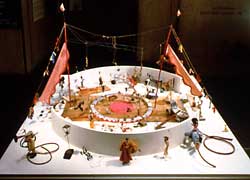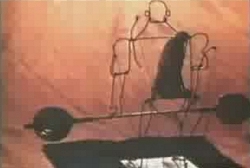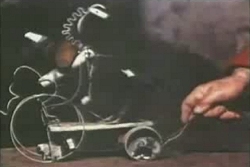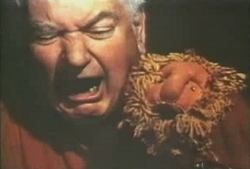Terry at Bent Objects makes these lovely whimsical figures and scenes with wire and everyday objects. They remind me of the wire figues in Calder’s Circus, and I can imagine them being brought to life as puppetry.
(via Craft Magazine)
Terry at Bent Objects makes these lovely whimsical figures and scenes with wire and everyday objects. They remind me of the wire figues in Calder’s Circus, and I can imagine them being brought to life as puppetry.
(via Craft Magazine)

(photo: Whitney Museum of American Art)
It’s funny how these things happen. Just the other day I was thinking about Alexander Calder‘s Circus, the film of which I saw a few years ago at the first national puppetry summit, and wondering if it might be on the net, and then yesterday Boing Boing linked to clips of it on YouTube, posted by sweetjuniper. There are four parts (Part 1, Part 2, Part 3,Part 4), together making up the whole film made by Carlos Vilardebo in 1961.
The circus was made during the late 1920’s, a precursor to Calder’s mobiles. He made the puppets from bits and bobs: ‘wire, wood, metal, cloth, yarn, paper, cardboard, leather, string, rubber tubing, corks, buttons, rhinestones, pipe cleaners, and bottle caps’.
‘Beginning in 1927, Calder performed the Circus in Paris, New York, and elsewhere. He would issue invitations to his guests, who would sit on makeshift bleachers munching peanuts, just like the real circus. With the crash of cymbals and music from an old gramophone, the circus would begin. It wasn’t the tricks or gimmicks of the circus that appealed to Calder, but the dynamic movement of bodies in space.’
— Adam Weinburg
I love the way the characters are caught so well by just a few outlines;

the mechanics;

and Calder’s upfront presence throughout:

I also really like how the tricks such as the trapeze artists actually work, but also have a randomness of success. There is also a great sense of humour driving it all.
The circus is now kept at the Whitney Museum of American Art in New York, but is too fragile to tour. However, it is on display there at the moment, until early September. Vilardebo’s film is available on DVD. There is apparently a second filmed version, Cirque de Calder, made in 1953 by Jean Painlevé.